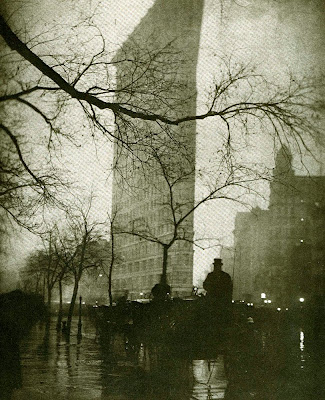
Stieglitz, Steichen, Strand
Masterworks from the Metropolitan Museum of Art
Malcolm Daniel
Metropolitan Museum of Art
Yale University Press (2010)
This is the companion publication to the current exhibit at the Metropolitan Museum of Art. (Stieglitz, Steichen, Strand runs through April 10, 2011). The book contains all of the plates from the exhibit and a well written essay by Malcolm Daniel, curator in charge of photographs for the museum.
While this book is beautifully printed with high quality image reproductions, it confirms for me the most resonating aspect of the exhibit, and that is the pictorial nature of Steichen's work. The work of Stieglitz and Strand can for the most part be fully appreciated in a high quality book. It is always best to see an actual print on the wall, but I don't believe the difference in visual appreciation is anywhere near as great for Stieglitz and Strand as it is for Steichen. I had never seen actual prints of Steichen's work before I went to this exhibit, and they blew me away. It was as if I was seeing his work for the very first time, and yet I had seen it in books many times.
The images involving Rodin are remarkable. Steichen visited Rodin's studio every weekend for a year before he asked to take portraits of the artist. The images Steichen made of Rodin's Balzac sculpture in the moonlight, using exposure times ranging from fifteen minutes to one hour are superb beyond words, and the image Rodin, Le Penseur is as close to a renaissance painting as a photograph can get.
 Edward Steichen. Rodin,Le Penseur.(1902)
Edward Steichen. Rodin,Le Penseur.(1902)There are three versions of The Flatiron Building in the exhibit, hung side by side in a commanding display. They are each slightly different in color toning, and were printed in 1904, 1905, and 1909. Again, I have seen this image in books dozens of times, but realize now that I have never truly seen it.
 Edward Steichen.The Flatiron Building, (1905)
Edward Steichen.The Flatiron Building, (1905)The works in this exhibit are all from the Met’s own collection, which began with a gift of photographs from Stieglitz in 1928. Stieglitz considered the acceptance of his gift by the museum’s board of trustees to be nothing short of miraculous in opening “its sacred halls to Photography”, and this exhibit provides a look at the building blocks of photography’s now accepted place among traditional fine art institutions. Masterpieces from each photographer are shown in separate galleries, with works spanning from Stieglitz’s 1893 Winter, Fifth Avenue to a portrait of Stieglitz taken by Strand in 1939. The exhibit clearly separates the distinct style and professional careers of each photographer, and at the same time tells the interwoven story that connects them.
1 comment:
I was fortunate enough to catch this exhibit just before it closed. Your comments are spot on. There is nothing like seeing the actual prints of these masters.
Your particular attention to Steichen is telling, and I find myself going thru something of the same shift, from Stieglitz to Steichen. I am presently reading Steichen's 'My Life in Photography' and the insights to the experiences of the early years of photography being accepted as an art form are wonderful. I highly recommend it if you have not read it yet.
Post a Comment